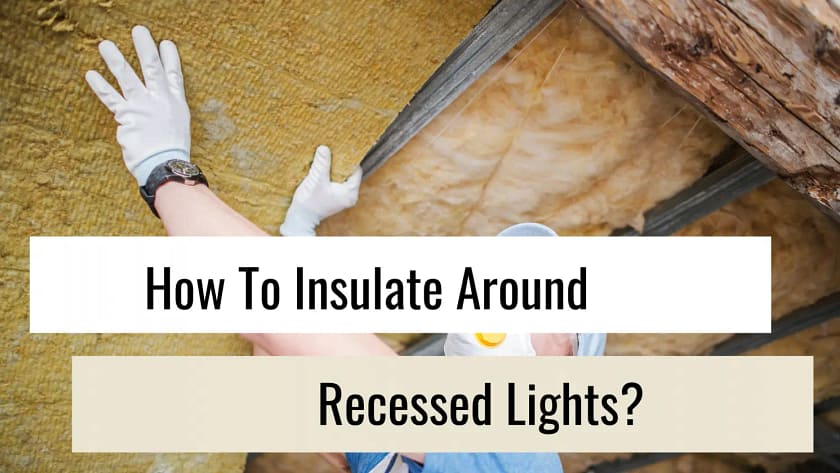Making your home comfortable and energy-efficient is the benefit of insulation. They keep the heat inside during the winter and cool air in the summer. Insulating with recessed lighting means there are wiring and fixtures in your way.
Therefore, split the insulation into two, so each side of the wire is nested. For recessed lighting, place light caps over fixtures and junction boxes, measure the box, and cut out the shape.
Then, place the cutout of insulation around the junction box or light caps and insert the rest of the insulation in the cavity as usual. Ensure the recessed fixture is IC rated before adding any insulation around it. If not, do not cover or touch these sources with any of the materials. Lights that are not IC-rated need baffles installed so air can flow.
The NEC allows at least three inches of space between the insulation and any heat-generating source.
Tip: In this post, I use the words baffles and light caps keep in mind they are the same thing; a protective cap for recessed lighting. This product is effective and cheaper than switching out all your old lights for IC-rated versions.
Insulation and Old fixtures and LEDs
While LEDs run cooler than traditional bulbs, their insides can get hot. Hence, you’ll still need to keep insulation away from these fixtures. Without insulations, recessed canisters can allow huge amounts of hot air into the ceiling, increasing your electrical bill in the process.
You can either replace your old fixtures with IC-rated options or install fire-rated recessed covers sealed with a 3M fire barrier. To install, clean the areas around the fixtures, cover the light and apply the sealant. Now, it is safe to add insulation around the fixture.
LEDs are cheaper to operate in the long run, but they can still get hot when they are in tight spaces in your ceiling.
Which Insulation to Choose With Recessed Lighting?
When it comes to recessed lighting and insulation, the type of material matters; for instance, fiberglass melts when they are close to heat, but they do not catch fire. They are not fire-retardant and are not the best choice for non-IC-rated canisters.
Blown-in cellulose fits better around joists and is fire-retardant. Although they have a higher fire resistance than fiberglass; it is better to install IC-rated or lighting caps around the fixture.
Lastly, the least flammable material you can use to insulate recessed lighting is mineral wool. They wouldn’t burn until the temperature reaches 1800 degrees Fahrenheit.
How To Insulate With Spray Foam Around Recessed Lighting?
When using spray foam in a place like your attic, it is best to use light caps to cover recessed lights. Light caps are placed over the fixture to protect the insulation materials from heat. In older homes, the canisters may not be IC-rated, so the caps allow the heat to dissipate safely out.
When applying spray foam, it spreads fast and can easily leak into your light and decrease its lifespan. Light caps are very inexpensive, and the application takes mins. Similarly, the light caps make servicing your fixtures easier because the caps are identifiable.
How To Clean Recessed Lights?
Clean recessed lighting by dusting inside the opening of the light. For deep cleaning, turn off and wait until the fixture is cool. Also, to be on the safe side, turn off the breaker to the room you are working with, gently wipe the bulb or replace it.
The best way to identify IC-rated lights is to look at the packaging. There is also a gasket that seals against the drywall to prevent any air from escaping. These canisters are designed to keep cool to the touch, so you can add insulation right over the top of IC-rated lights without worrying about them.
How To Tell If Recessed Lighting Is IC-Rated?
IC-rated lights can safely come in contact with insulation or any type of combustible. Non-IC-rated lights like older canisters can get too hot and requires continuous airflow to cool down. In drafty places, it can leak conditioned air into the attic all year round.
The best way to identify IC-rated lights is to look at the packaging. There is also a gasket that seals against the drywall to prevent any air from escaping. These canisters are designed to keep cool to the touch, so you can add insulation right over the top of IC-rated lights without worrying about them.
To Recap
Insulation with recessed lighting can be tricky, especially if you have a non-IC-rated fixture. One common solution is to place light caps over the light so that the insulation would not touch your canisters.
Even with IC-rated, the caps protect the lights and make servicing easier. Furthermore, converting your lights to LEDs saves energy and produces less heat.





